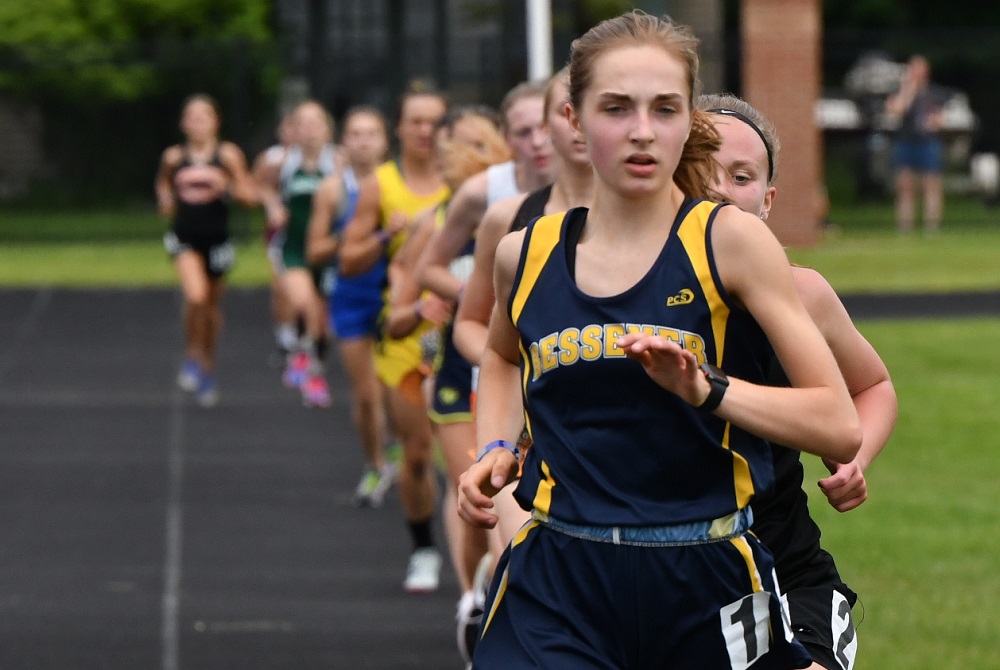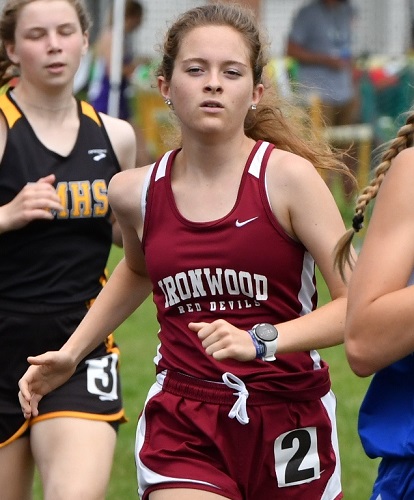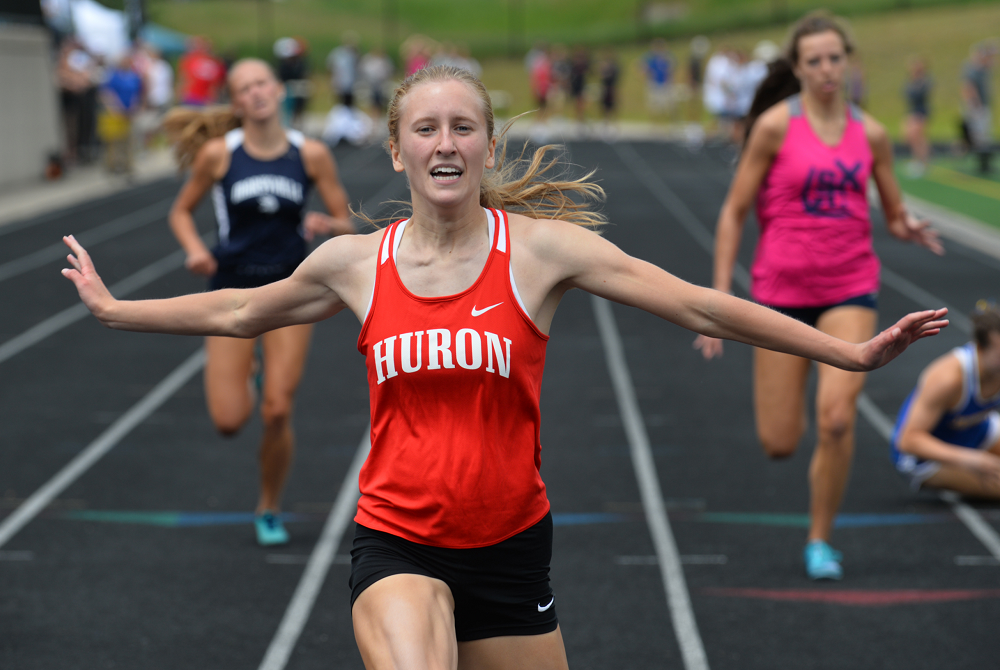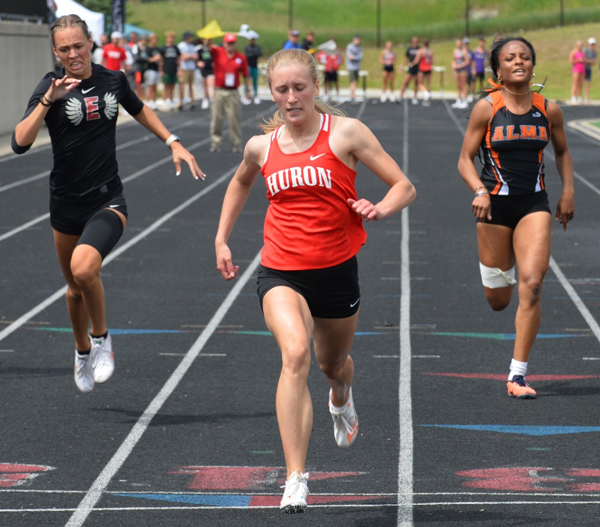
Ironwood's Smith Sisters, Bessemer's Stone Set Fast Pace in Western UP
By
John Vrancic
Special for MHSAA.com
May 9, 2022
IRONWOOD — There are at least three shining stars on the western horizon in Upper Peninsula girls track as Ironwood junior Lilley Smith, her freshman sister Aubrey and Bessemer junior Natalie Stone are setting the pace among distance runners on the Gogebic Range.
 Aubrey Smith won the 1600-meter run at 6 minutes, 0.5 seconds in last Monday’s Jack Kraemer Invitational on a cloudy and chilly day at Longyear Field.
Aubrey Smith won the 1600-meter run at 6 minutes, 0.5 seconds in last Monday’s Jack Kraemer Invitational on a cloudy and chilly day at Longyear Field.
Stone, who had been dealing with leg issues, was runner-up at 6:11.47, and Lilley Smith took fourth (6:14.03), just 34 hundredths of a second behind senior Olivia Soltero of Washburn-Port Wing South Shore (Wis.).
Lilley then dominated the 3,200 at 13:34.16, nearly two minutes ahead of the field.
“In distance running we’re competitive, yet everybody is friendly,” said Lilley Smith. “You gain respect for yourself and others.
“Aubrey has an amazing kick. We started real early. I started in seventh grade and fell in love with it.”
Aubrey Smith was in sixth grade when she began her running career.
“Our mom ran marathons and told us great stories about running,” she said. “When you’re done with a race, you look back at what you did and you’re proud of what you accomplished.”
 Stone also ran in the 1,600 relay in which the Speedgirls took fifth.
Stone also ran in the 1,600 relay in which the Speedgirls took fifth.
“Everything is very tight,” she said. “I felt good today, but I’m still a little sore. I’m just so happy to be able to run because I love it so much. Running is a lifetime sport, and I want to do it all my life. I had missed six weeks. This is only my second day back, and my lungs aren’t quite there yet.”
Last fall, Aubrey Smith was runner-up and Lilley placed sixth at the Upper Peninsula Division 2 Cross Country Final at Marquette. Smith was third in the 1,600 and second in the 3,200 at last spring’s UPD2 Track & Field Finals.
“Aubrey is very talented and hard working,” said Ironwood cross country coach Ben Schmandt. “It’s challenging for a freshman to compete at the highest level. Lilley is also one of the hardest workers on the team. She exemplifies perseverance. She fell down at Hancock and was the first one to finish (fourth overall in cross country) with bleeding feet. That’s dedication in the truest form. She’s one of the most coachable kids we’ve had.”
Stone placed third at the UPD2 Cross Country Final and in the 1,600 in UPD3 last spring at Kingsford behind Mid Peninsula’s Landry Koski and Rudyard’s Tristan Smith.
“Lilley and Aubrey push me, and I push them,” said Stone. “It’s so much fun to run with them. Hopefully, the U.P. Track Finals will go better for me this year. Landry is a very good runner. She just came from behind and won it. She has a real strong kick.”
Bessemer coach Tracy Rowe refers to Stone as one of the team’s leaders.
“Natalie is a great runner,” she said. “You feel so bad for kids when they get hurt. I’m just glad she can run and feels better.”
At Friday’s Ontonagon Invitational, Aubrey Smith placed fourth (6:10.8) and Lilley was fifth (6:11.2) in the 1,600. Lilley then took second in the 3,200 (13:10.3).
“We enjoy running with each other,” Aubrey said after the meet in Ironwood “We give each other the thumbs up when we pass each other in a race.”
“I love Natalie,” Smith added. “I’ve been running against her since middle school.”
 John Vrancic has covered high school sports in the Upper Peninsula since joining the Escanaba Daily Press staff in 1985. He is known most prominently across the peninsula for his extensive coverage of cross country and track & field that frequently appears in newspapers from the Wisconsin border to Lake Huron. He received the James Trethewey Award for Distinguished Service in 2015 from the Upper Peninsula Sportswriters and Sportscasters Association.
John Vrancic has covered high school sports in the Upper Peninsula since joining the Escanaba Daily Press staff in 1985. He is known most prominently across the peninsula for his extensive coverage of cross country and track & field that frequently appears in newspapers from the Wisconsin border to Lake Huron. He received the James Trethewey Award for Distinguished Service in 2015 from the Upper Peninsula Sportswriters and Sportscasters Association.
PHOTOS: Bessemer’s Natalie Stone leads a race during last season’s UPD3 Finals at Kingsford. (Middle) Ironwood’s Lilley Smith is among those pacing the pack during last season’s UPD2 Final in the 1,600. (Photos by Cara Kamps.)

Multi-Sprint Champ Racing to Finish Huron Career Ahead of the Rest Again
By
Keith Dunlap
Special for MHSAA.com
May 25, 2023
NEW BOSTON – If there was one thing Elizabeth Anderson took pride in elementary school, it was simply showing that she could outrun everyone in sight.
 In fact, Anderson has an explanation for all the success she had in those playground races.
In fact, Anderson has an explanation for all the success she had in those playground races.
“Dominance when you are in elementary school,” Anderson quipped. “I don’t think I ever had a nickname. I just think everyone knew I was fast.”
Years later, pretty much everyone who follows track & field in the state of Michigan can attest to that.
A senior for New Boston Huron, Anderson has been faster than most other competitors in the state during her three-year high school career (with her freshman season in 2020 canceled due to COVID-19).
Last year, Anderson won titles at the Lower Peninsula Division 2 Finals in the 200-meter (25.07) and 400-meter (56.28) dashes, and was runner-up in the 100-meter dash (12.23).
Often, top sprinters focus on one or two of those three races. But Anderson is certainly a different breed of sprinter because she does all three.
In fact, she holds school records in all three of those events, and if all that weren’t enough, Anderson is a part of all three sprint relay teams.
“It is hard to give her events off,” said New Boston Huron head girls track coach Danielle Lobato.
Despite the different styles the 100, 200 and 400-meter dashes present, Anderson said there usually isn’t much adjusting when she goes from one of those races to another.
 The strategy is simply, “Let’s beat the other girls to the finish line.”
The strategy is simply, “Let’s beat the other girls to the finish line.”
“I don’t really go into each race changing up how I would run,” she said.
While enjoying and succeeding in all three races, Anderson said she actually does have a favorite among them.
“I would say the 400 is probably my favorite,” she said. “Even though it hurts, it’s satisfying to see how much you can get your time down in the 400 compared to any other race.”
Anderson said she started running track in sixth grade, but really got serious about it during the summer after her sophomore season, when she was invited to run for a local club.
Eventually, that led to her competing over the winter in indoor events.
She lived and breathed track so much that last fall, she decided to not run cross country so she could focus on a weightlifting regimen aimed at developing more leg strength.
“Once I started doing summer track, I realized I wanted to be doing this all the time,” she said.
Lobato said oftentimes in practice, Anderson is a de facto coach, given there is no better person she can think of for the younger runners on the team to learn from.
“I can’t always demonstrate these things I’m trying to teach,” she said. “You get to see it in real life (from Anderson), not in a YouTube video.”
After winning the 100, 200 and 400-meter dashes at her Regional meet last week, Anderson has her sights set on achieving the same trifecta of titles at next Saturday’s Finals in Grand Rapids.
Anderson has signed to run track at Michigan State, but has been plenty motivated to keep producing this spring in her final high school season.
“I’m really looking to defend my titles,” she said. “That is what is really motivating me to keep going. I want to keep in shape for the college season. I don’t want to lose any of the progress I have made. Ultimately, I just love running track.”
And since elementary school, Anderson has loved — and succeeded in — outrunning everyone else to the finish line.
“We knew we were getting something special,” Lobato said of when Anderson arrived in high school. “But you never expect this. All that she has accomplished is amazing.”
 Keith Dunlap has served in Detroit-area sports media for more than two decades, including as a sportswriter at the Oakland Press from 2001-16 primarily covering high school sports but also college and professional teams. His bylines also have appeared in USA Today, the Washington Post, the Detroit Free Press, the Houston Chronicle and the Boston Globe. He served as the administrator for the Oakland Activities Association’s website from 2017-2020. Contact him at [email protected] with story ideas for Oakland, Macomb and Wayne counties
Keith Dunlap has served in Detroit-area sports media for more than two decades, including as a sportswriter at the Oakland Press from 2001-16 primarily covering high school sports but also college and professional teams. His bylines also have appeared in USA Today, the Washington Post, the Detroit Free Press, the Houston Chronicle and the Boston Globe. He served as the administrator for the Oakland Activities Association’s website from 2017-2020. Contact him at [email protected] with story ideas for Oakland, Macomb and Wayne counties
PHOTOS (Top) New Boston Huron's Elizabeth Anderson clears the finish line during last season's LPD2 400 race. (Middle) Anderson, middle, outpaces the field to also win the 200. (Click for more from RunMichigan.com.)

